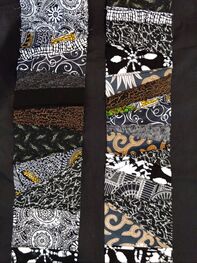|
If you've ever read my artist statement, you might recall that one of the things that I like to do is to put together very disparate fabrics to make them work together as a unified whole. You might also know that when I don't know what I want to do next, I create yardage to keep myself going. I color-sort pieces from my scrap bin and start piecing them together. Today's post is about how those two things have come together lately. I didn't have a good idea for a new jacket so I've been making yardage. Usually when I do this, I have no end use in mind. I just try to put enough small scraps together to create something large enough to be the basis of a project or at least a major component. This time I wanted to make sure that the pieces I created could be used in an unlined jacket. I want to make sure that the insides of these jackets look as nice as the outsides. That means that I can't do just plain seams. Even if I pinked or zig-zagged the seam allowances, the insides of the pieced sections would look really messy. I need to do some type of special seam that hides the raw edges. For the main seams of these jackets I do flat-felled seams (like those on denim jeans). For a number of reasons I didn't want to do those for piecing small bits.  After much thought, I decided to try French seams. These are usually done on sheer fabrics. Each seam is stitched twice. First you make a narrow seam with wrong sides of the fabric together. Then you fold the sides back on themselves so the right sides are together and stitch another slightly wider seam that encloses the raw edges. The resulting tuck ends up inside the garment. For this project I decided to start with the fabrics right side together so the tuck would end up on the outside adding a textural dimension to the finished piece.
I had expected that I would need something nearly plain or with just a subtle pattern but nothing like that seemed to work. Then I decided to look at some bolder patterns just in case. It still surprises me that all these patterns go as well together as they do. Then yesterday I got that same kind of surprise for another of these projects. I'd pieced together lots of black and white fabrics thinking I'd intersperse them with plain black for another jacket. Then when I dug out out my black fabrics, nothing was exactly the right color or weight. So I set aside those strips and went on to piecing another set of colors. When I finished with that color set, I went back to the black & white. Just for the heck of it I pulled out a really bold black and white batik to see if it could possibly work. To my great surprise (again) it seemed to pull the pieced strips together into a whole much better than the plain black. When I look at the piece on the right, I see stripes and individual patterns. When I look at the center picture I see a blending of colors and patterns with little standing out. I think that will happen even more when it is all put together. So you'll have to wait a bit to see how this all works out in the end. I've got a lot of work to do on it yet, but I think I have a plan - even if it isn't the one I originally had in mind. If there's a lesson in all this, it is -- just be brave, just try it. You might be suprised.
1 Comment
Pamela Jacobs
8/22/2019 08:18:46 am
What an inspiring website! I want to explore these techniques more during my winter downtime.
Reply
Your comment will be posted after it is approved.
Leave a Reply. |
AuthorMother & daughter, Ann Lee & Sonja Lee-Austin share their joys and struggles in their art and lives. Archives
June 2021
Categories
All
|




 RSS Feed
RSS Feed